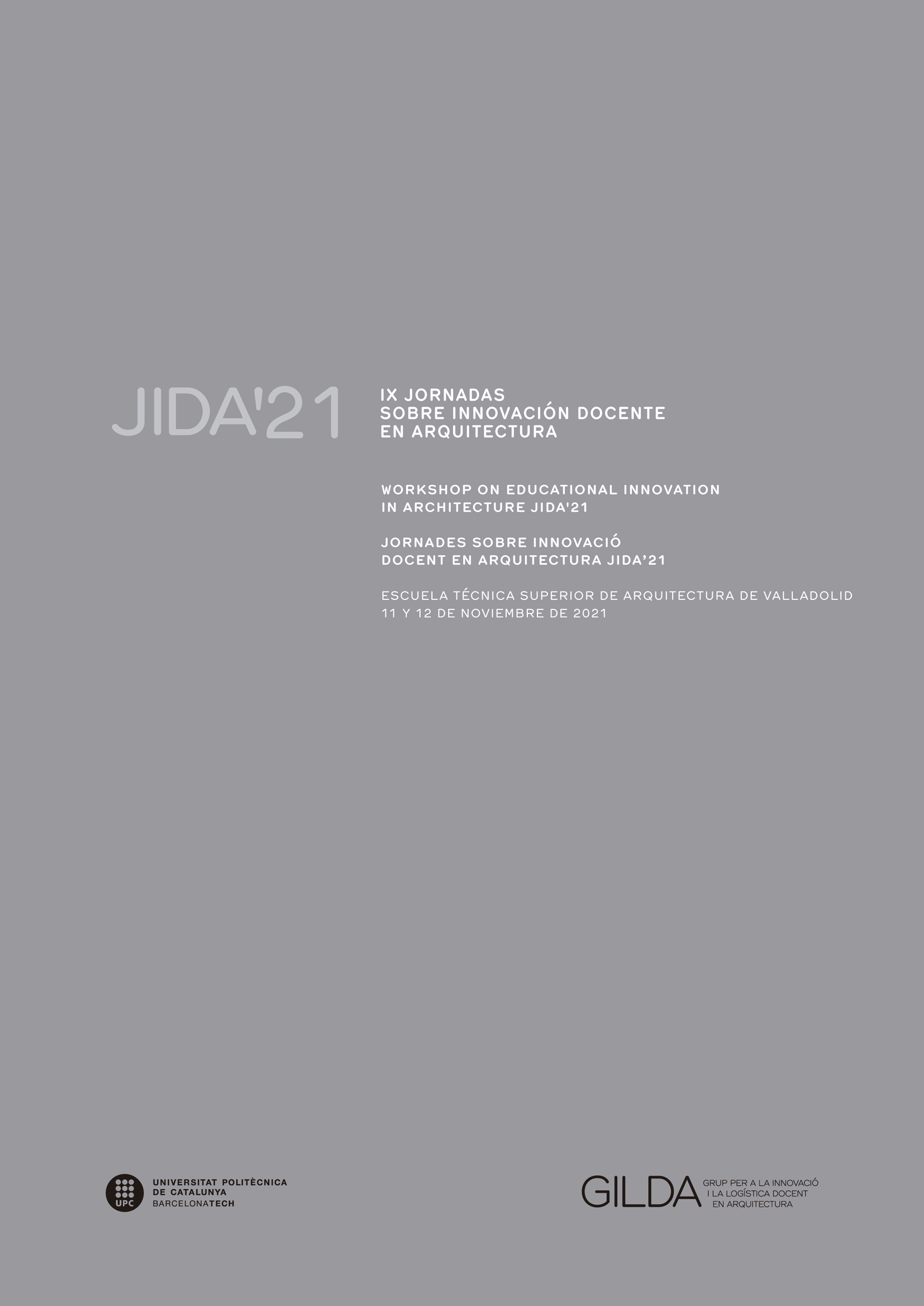Integración de investigación basada en el arte en programas de diseño
DOI:
https://doi.org/10.5821/jida.2021.10533Palabras clave:
arte, proyecto, disciplinariedad, materialidad, autoría, criticidad proyectiva, agencia material, estrategias de ideterminaciónResumen
Este artículo se centra en el uso de la investigación basada en el arte para enriquecer metodologías activas en planes de estudio de diseño. Basado en el análisis de dos casos de estudio, argumenta la necesidad de explorar una hibridación de metodologías y disciplinas para fomentar prácticas de diseño disruptivas e innovadoras dentro de los programas académicos en el campo de la arquitectura expandida. Los casos de estudio articulan la arquitectura efímera con prácticas artísticas a través de un enfoque radical sobre la materialidad, que se plantea como el punto de partida de cada proyecto. En lugar de entender la materialidad como una decisión de segundo nivel que se aborda después de haber formulado el concepto de proyecto, ésta se aborda directamente para definir el concepto de diseño y su resolución detallada. Un resultado relevante de los casos de estudio es la exploración activa de nuevas formas de autoría, a caballo entre el autor autárquico de modelos posrománticos y la disolución de la autoría de algunos modelos colaborativos contemporáneos.
Citas
ALLEN, S. (2000). Practice: Architecture, Technique and Representation. Abingdon, OX: Routledge.
AWAN, N.; SCHNEIDER, T.; and TILL, J. (2011). Spatial Agency. Other Ways of Doing Architecture. London and New York: Routledge.
BARAD, K. (2003). “Posthumanist performativity: Toward an understanding of how matter comes to matter” in Signs: Journal ofWomen in Culture and Society, 28(3), p. 801-831.
BENNETT, J. (2010). Vibrant Matter: A Political Ecology of Things. Durham and London: Duke University Press.
BERNSTEIN, J. (2015). “Transdisciplinarity: A Review of Its Origins, Development, and Current Issues” in Journal of Research Practice, 11(1).
CARLILE, P.R. et al. (2013). “How Matter Matters: Objects, Aftifacts, and Materiality in Organization Studies” in Carlile, P. R. et al. (eds) How Matter Matters. Objects, Artifacts and Materiality in Organization Studies. Oxford, UK: Oxford University Press.
DANVERS, J. (2003). “Towards a radical pedagogy: Provisional notes on learning and teaching in art & design” in International Journal of Art and Design Education, 22(1), p. 47-57. doi: 10.1111/1468-5949.00338.
DELL, C. (2019). The Improvisation of Space. Berlin: Jovis.
DEUTSCHE, R. (1996). Evictions: Art and Spatial Politics. Cambridge, MA: The MIT Press.
DILLON, P. and HOWE, T. (2007). “An epistemology of presence and reconceptualisation in design education”, Interchange, 38(1), p. 69-88. doi: 10.1007/s10780-007-9013-4.
FRASER, N. (2014). “Behind Marx”s Hidden Abode: For an Expanded Conception of Capitalism” in New Left Review, 86, pp. 55-72.
GHERARDI, S. and PERROTTA, M. (2013). “Doing by Inventing the way of Doing: Formativeness as the Linkage of Meaning and Matter.” in Carlile, P. R. et al. (eds) How Matter Matters. Objects, Artifacts and Materiality in Organization Studies. Oxford, UK: Oxford University Press, p. 227-260.
GIDDENS, A. (1984). The Constitution Of Society: Outline of the Theory of Strcuturation. Berkley: University of California Press.
HARAWAY, D. (1988). “Situated Knowledges: The Science Question in Feminism and the Privilege of Partial Perspective" in Feminist Studies, 14(3), p. 575-599. doi: 10.2307/3178066.
HICKMAN, R. ed. (2008). Research in Art & Design Education: Issues and Exemplars. Bristol & Chicago: Intellect.
HINSON, D. (2007). “Design as Research: Learning from Doing in the Design-Build Studio” in Journal of Architectural Education, 61 (1), p. 23-26.
JOKELA, T. and HUHMARNIEMI, M. (2018). “Art-based action research in the development work of arts and art education” in Coutts, G.; Hárkönen, E.; Huhmarniemi, M. and Jokela, T. The Lure of Lapland. Rovaniemi: University of Lapland.
LATOUR, B. (2005). Reassembling the Social. An Introduction to Actor-Network-Theory. New York: Oxford University Press.
MAIZ, I. and MÜLLER, M. (eds) (2010). Joseph Beuys: Parallelprozesse. Düsselfdorf: Kunstsammlung Nordrhein-Westfalen.
MÄKELÄ, M.A. and LÖYTÖNEN, T. (2015). “Enhancing material experimentation in design education” in LearnxDesign, The 3rd International Conference for Design Education Researchers. Chicago, Illinois.
MORTON, T. (2017). Humankind. Solidarity with Nonhuman People. London and New York: Verso.
ORTEGA, L. (2017). The Total Designer. Authorship in Architectutre in the Post-digital Age. New York, Barcelona: Actar Publishers.
PAEZ, R. (2019a). Operative Mapping: Maps as Design Tools. New York and Barcelona: Actar Publishers.
PAEZ, R. (ed.) (2019b). Només Paper. Barcelona: Cercle Artístic Sant Lluc.
PAEZ, R. (In press). “Design as Playground: Exploring Design Through Game-based Formats” in Space and Culture, special issue: Cities as Playgrounds/Playgrounds as Cities: Rethinking Urban Play, Civic Engagement and Socio‐Spatiality.
PAEZ, R. and VALTCHANOVA, M. (2021). “Harnessing Conflict: Antagonism and Spatiotemporal Design Practices”, Temes de Disseny, 37 Invisible Conflicts: The New Terrain of Bodies, Infrastructures and Communication, p. 182-213. doi: 10.46467/TdD37.2021.182-213.
RENDELL, J. (2006). Art and Arcitecture: A place Between. London: I.B.Tauris.
SOMOL, R. and WHITING, S. (2002). “Notes around the Doppler Effect and Other Moods of Modernism” in Perspecta 33, p. 72-77. doi: 10.2307/1567298.
TURPIN, E. (ed.) (2014). Architecture in the Anthropocene: Encounters Among Design, Deep Time, Science and Philosophy. Ann Arbor, MI: Open Humanities Press.
WALDHEIM, C. (2006). “Strategies of Indeterminacy in Recent Landscape Practice” in Public, 33 (Errata), p. 80-86. Available at: http://pi.library.yorku.ca/ojs/index.php/public/article/viewFile/30088/27649.
ZAMENOPOULOS, T. and ALEXIOU, K. (2018). “Co-Design As Collaborative Research.” in Connected Communities Foundation Series. Bristol: Bristol University/ AHRC Connected Communities Programme.






















